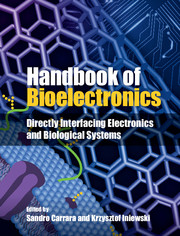Refine listing
Actions for selected content:
881 results in Ebooks in nanotechnology
13 - Not just plain vanilla DNA nanotechnology: other pairings, other backbones
-
- Book:
- Structural DNA Nanotechnology
- Published online:
- 05 December 2015
- Print publication:
- 07 January 2016, pp 213-230
-
- Chapter
- Export citation
11 - Self-replicating systems
-
- Book:
- Structural DNA Nanotechnology
- Published online:
- 05 December 2015
- Print publication:
- 07 January 2016, pp 186-197
-
- Chapter
- Export citation
12 - Computing with DNA
-
- Book:
- Structural DNA Nanotechnology
- Published online:
- 05 December 2015
- Print publication:
- 07 January 2016, pp 198-212
-
- Chapter
- Export citation
9 - DNA origami and DNA bricks
-
- Book:
- Structural DNA Nanotechnology
- Published online:
- 05 December 2015
- Print publication:
- 07 January 2016, pp 150-171
-
- Chapter
- Export citation
Index
-
- Book:
- Structural DNA Nanotechnology
- Published online:
- 05 December 2015
- Print publication:
- 07 January 2016, pp 251-257
-
- Chapter
- Export citation
Contents
-
- Book:
- Structural DNA Nanotechnology
- Published online:
- 05 December 2015
- Print publication:
- 07 January 2016, pp vii-viii
-
- Chapter
- Export citation
Frontmatter
-
- Book:
- Structural DNA Nanotechnology
- Published online:
- 05 December 2015
- Print publication:
- 07 January 2016, pp i-vi
-
- Chapter
- Export citation
8 - DNA nanomechanical devices
-
- Book:
- Structural DNA Nanotechnology
- Published online:
- 05 December 2015
- Print publication:
- 07 January 2016, pp 130-149
-
- Chapter
- Export citation
4 - Single-stranded DNA topology and motif design
-
- Book:
- Structural DNA Nanotechnology
- Published online:
- 05 December 2015
- Print publication:
- 07 January 2016, pp 44-63
-
- Chapter
- Export citation

Structural DNA Nanotechnology
-
- Published online:
- 05 December 2015
- Print publication:
- 07 January 2016

Handbook of Bioelectronics
- Directly Interfacing Electronics and Biological Systems
-
- Published online:
- 05 September 2015
- Print publication:
- 06 August 2015
15 - Biofuel cells
- from Part III - Fuel cells
-
-
- Book:
- Handbook of Bioelectronics
- Published online:
- 05 September 2015
- Print publication:
- 06 August 2015, pp 197-201
-
- Chapter
- Export citation
25 - CMOS technologiesfor retinal prosthesis
- from Part V - Bionics
-
-
- Book:
- Handbook of Bioelectronics
- Published online:
- 05 September 2015
- Print publication:
- 06 August 2015, pp 313-324
-
- Chapter
- Export citation
17 - Switchable electrodes and biofuel cells logically controlled by chemicaland biochemical signals
- from Part III - Fuel cells
-
-
- Book:
- Handbook of Bioelectronics
- Published online:
- 05 September 2015
- Print publication:
- 06 August 2015, pp 215-238
-
- Chapter
- Export citation
21 - Electronicmodeling of synthetic genetic networks
- from Part IV - Biomimetic systems
-
-
- Book:
- Handbook of Bioelectronics
- Published online:
- 05 September 2015
- Print publication:
- 06 August 2015, pp 266-274
-
- Chapter
- Export citation
16 - Advances andapplications in biofuel cells
- from Part III - Fuel cells
-
-
- Book:
- Handbook of Bioelectronics
- Published online:
- 05 September 2015
- Print publication:
- 06 August 2015, pp 202-214
-
- Chapter
- Export citation
22 - Introduction to bionics
- from Part V - Bionics
-
-
- Book:
- Handbook of Bioelectronics
- Published online:
- 05 September 2015
- Print publication:
- 06 August 2015, pp 277-280
-
- Chapter
- Export citation
Index
-
- Book:
- Handbook of Bioelectronics
- Published online:
- 05 September 2015
- Print publication:
- 06 August 2015, pp 569-577
-
- Chapter
- Export citation
8 - Introduction to biosensors
- from Part II - Biosensors
-
-
- Book:
- Handbook of Bioelectronics
- Published online:
- 05 September 2015
- Print publication:
- 06 August 2015, pp 105-108
-
- Chapter
- Export citation
19 - Epidermal electronics – flexible electronics for biomedicalapplications
- from Part IV - Biomimetic systems
-
-
- Book:
- Handbook of Bioelectronics
- Published online:
- 05 September 2015
- Print publication:
- 06 August 2015, pp 245-255
-
- Chapter
- Export citation
